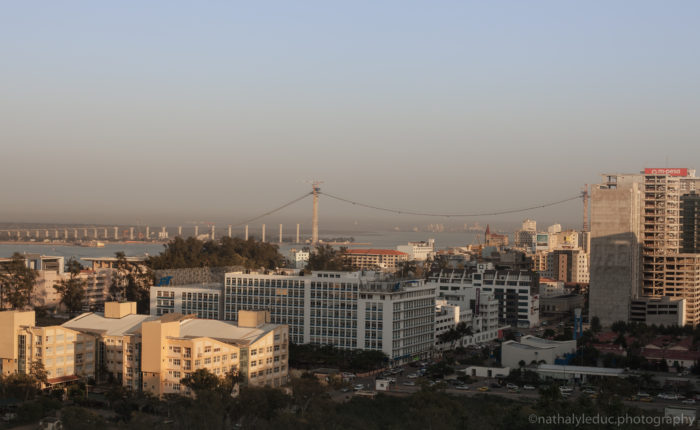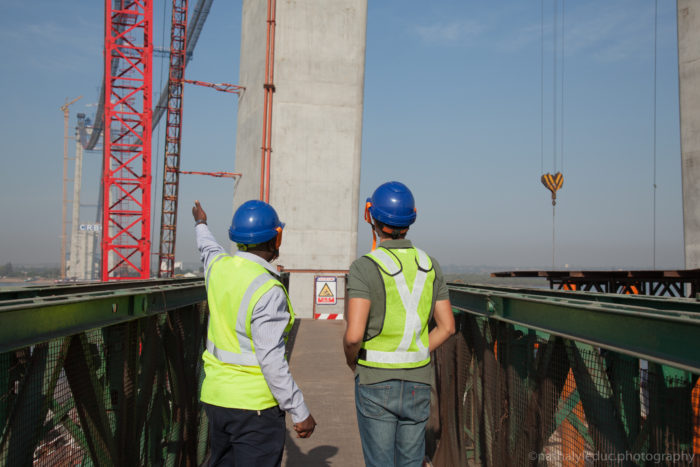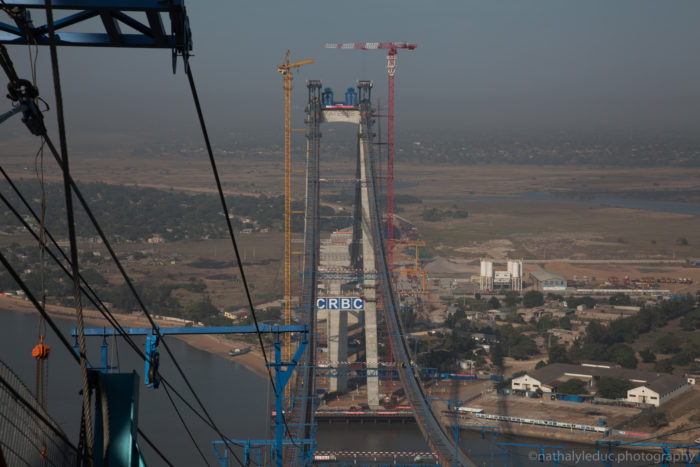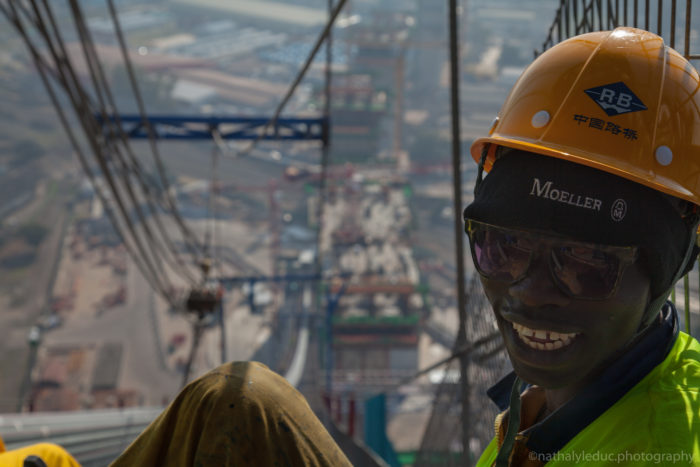Running for Resources Again?
As industrialization took off in Europe at the 19th Century, Imperialists rushed to Africa to ensure the natural resources necessary for powering the metropole. Violence and deep exploitation followed, completely impeding the development of the African countries. There were no perks for Africa during the times of European colonizers.

Media has been pointing out to a new scramble for African resources, but this time involving Asian powers as India, China and Japan. These narratives normally come packed with scepticism [i]. Last June I had the opportunity of glancing inside of the epic Maputo-Katembe bridge construction led by China (Figure 1). This is an attempt to recount the story of that day and how it changed my perspective about China in Africa. All of what I narrate here is based on notes I took and memories. But before I come to what I encountered there, let me tell you a little bit about the project itself.
The Maputo- Katembe Bridge from the outside

I used the adjective epic to describe the bridge because it is, indeed, epic. The Maputo-Katembe bridge stretches for 3km, which makes it the longest extension bridge in the continent. It is suspended 60m, so ships can still cross underneath it. The costs, estimated around 750m USD, were financed by the Export-Import Bank of China[ii] and the construction is being conducted by China Roads and Bridges Corporation (CRBC) [iii]. Many of the materials necessary for the construction come in gigantic ships directly from China. If everything goes according to plans, it should be done by early 2018.
There are a lot of controversies regarding the relevance of this bridge. It connects the highly populated and urban Maputo to the impoverished fisher´s village Katembe (Figure 2). Currently, there are two ways of reaching Katembe: either by an obsolete low-capacity ferry, which takes around an hour, or going around the bay, which takes almost three hours. Thus, from a logistical perspective, the bridge makes some sense, but those against it contend that there are other things that should be prioritized in Mozambique as schools or hospitals. It is argued that the bridge would better connect Maputo to Durban, SA and thus incentivize the economy. Many believe that this would make Chinese imports of natural resources cheaper because of lower transportation costs.
The Maputo- Katembe Bridge from the inside

After seeing some pictures of Maputo from one of the 140m high towers of the bridge, my partner contacted the person who posted them on social media. He was a South African engineer that moved to Mozambique to work with CRBC. As my partner told him we were curious students of filmmaking, he invited us to come to the construction site, talk to the workers, and make some footage of our own.
So, in a foggy Monday morning we took a cab to baixa, where the headquarters of CRBS is located. I was very sceptical that we would actually meet someone who would take us to check the controversial bridge from the inside. Although colossal and strikingly apparent from everywhere in Maputo, I felt that the bridge was very intangible to us. I could not be more wrong: after a couple of minutes waiting, we saw our online colleague walking in our direction carrying two hard hats. “You need to wear them all the time in the construction site” he said as we greeted. We walked into the facilities, which were built for the project. He told us about how more than a thousand-people worked there daily. As we entered the building, he introduced us to everyone that we came across: a German engineer, a Chinese engineer, a Russian engineer and a Mozambican engineer. We were then asked to wait in a meeting room.
Inside the room we could see the conceptual project of the bridge at the walls. Despite the chunk of numbers, distances, and angles all of which I could not understand, what stroke me the most was the fact that everything was written in different languages. While trying to make sense out of that, an engineer specialized in security, who I will call Matt, came in. He told us he would be leading our visit and asked for our shoe sizes for safety boots. We got the boots and went directly to the parking lot, where a driver would take us to the tower.
The driver, an older Mozambican man, friendly greeted us. The atmosphere was chilled as Matt, originally from Zimbabwe, attempted to speak Portuguese with him. Matt had arrived around a year ago, from another infrastructure project elsewhere, and told us he enjoyed life in Maputo. He also told us that the driver was some kind of respected figure in the site. He has been working there since 2014, when the project started. I could not help but think about what will happened with the almost 1000 workers employed there everyday once the bridge is done. We were in the car for less than 5 minutes when it stopped at an area with various cranes and machines (Figure 3).

Matt told us he would take us to the highest tower at the Maputo end of the bridge (Figure 4). On our way to the lift, we encountered various workers with the same hard hats and boots we had. I asked Matt about security and how was the death toll so far. He proudly told us that they were striking great numbers given the scale of the project. There were external consultants, mainly a German company, assuring quality and safety controls if I understood correctly.
Here is a tip for adrenaline junkies: there are very few things more hard-core than taking a construction lift 140m up in a bridge being constructed. As the three of us were sitting in this narrow cage, Matt told me everything was going to be fine: “I take this lift many times every day”. I was very scared, but my partner was okay. She told me later that she could only see the work being done around the lift column, for the wind was getting increasingly louder. Once we reached the highest point, I was astonished. For those who do not know Maputo, it is a gorgeous city, but it lacks a spot from where you can see it from above. We were in that impossible spot.

We could see the ocean in between our feet from up there, as the floor was some kind of fence with holes on it. Many workers were on the steel cables that went from one tower until the other one at the Katembe side. “When I have time”, Matt said, “I catwalk to Katembe and have lunch at the fisher´s village. They have great squid” (Figure 5). Matt introduced us to a group of workers, and we found out that the same kind of diversity present at the headquarters at ocean level, was present at the tower. Construction workers from China, Russia and Mozambique (Figure 6). That was, in a positive sense, the bridge of babel. I still wonder how can they speak to each other, tough. These workers would take the same lift we took and spend the complete day up there. They had a small toilet and lunch would be brought up for them.
This time is different?

As Matt took us back to headquarters, we chatted about various things. He told us he has been moving in Africa from project to project for years. We walked through the office again and many of the engineers asked us about our impressions. We said our goodbyes and left very surprised and intrigued by what just happened.
Although much of the details felt into oblivion, the main lessons from that visit still entertain thoughts about the role China wants to assume in the global order and how some portray these endeavours. The international pool of know-how I saw at all levels of the bridge construction seemed as a very prone place for sharing knowledge, both for the Chinese leading the project and everybody else. I had the genuine impression that those involved were thrilled about it and that we were presented to a representative sample of what was going on there. Growing exposure to the Chinese way of conducting things, through such projects, is very valuable.
I had the chance to look into one of these projects that are normally described as part of bigger chinese colonial endeavours (footnote i). I do not doubt they come dovetailed with material, economic, and political interests. Nevertheless, what I saw in that one big bridge did not strike me as colonizing at all.
PS: all pictures were taken by my partner, for more interesting shots of Mozambique: https://nathalyleduc.photography
[i] Just google the following formula (China colonizing Africa) + any big media (e.g. nyt, bbc, the economists)
[ii] http://english.eximbank.gov.cn/en/
[iii] http://www.crbc.com/site/crbcEN/index.html